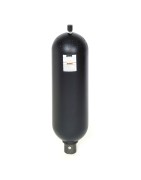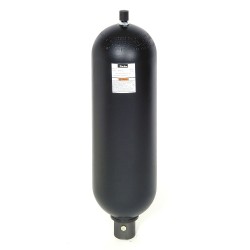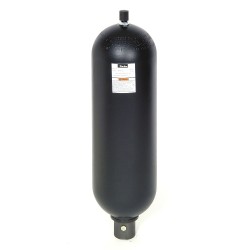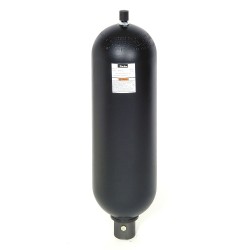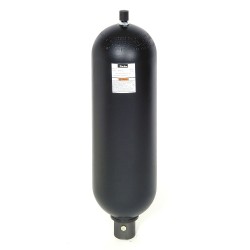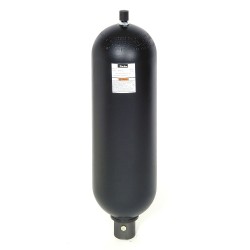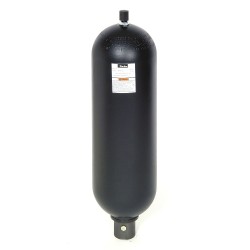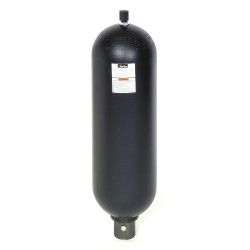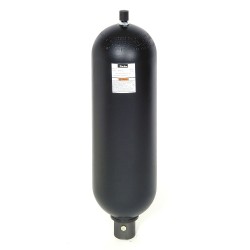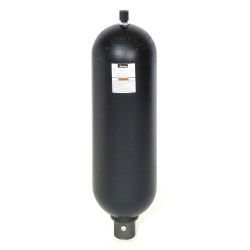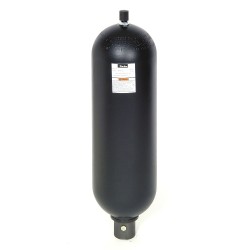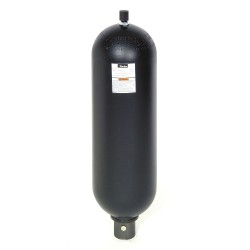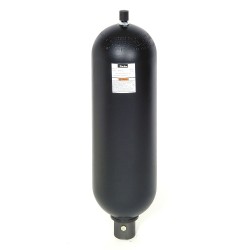Transfer Barrier Accumulators - Parker BT Series
Parker’s transfer barrier accumulator is a proven design which has served both the industrial and mobile hydraulic markets, providing energy management solutions for many hydraulic system applications. Offering a standard, globally certified transfer barrier accumulator (ASME, AS1210, CE, and CRN rated) is Parker’s approach at one shell design certified for most markets, geographies and applications.
We offer the broadest line of quality products, including:
• 2-1/2 Gallon (2.5 G), 5 Gallon (5 G), 10 Gallon (10 G), 11 Gallon (11 G), and 15 Gallon (15 G) capacities
• 3,000 psi (3 KPSI) - 10,000 psi (10 KPSI)
• Global certifications (ie, ABS, ASME, AS1210, CRN, DNV, DOSH, NR-13, PED (CE), SELO, ASME app 22)
• Bladder compounds (Nitrile, Hydrin, Fluorocarbon, Butyl, EPR, etc)
• Fluid Ports (SAE, NPT, Code 61 & 62, BSPP, High Flow, etc)
• Safety Fuse Options
• Mounting Accessories
Parker transfer barrier accumulator products are made to the highest quality standard and because of our in-house bladder molding operations, we offer extremely competitive lead times. The heart of any transfer barrier accumulator is the actual rubber bladder bag, and Parker bladders are engineered and manufactured in our own facility and subjected to our own high quality inspection standards.
Why Use Transfer Barrier Accumulators?
Separation of two fluids:
A Transfer Barrier Accumulator can also be used to separate two liquids or a gas and liquid. It is usually a question of separating two liquids, one of which is aggressive or contaminated. To limit the number of parts in contact with the aggressive liquid, it is common practice to put the aggressive fluid inside the bladder and therefore connect on what is normally the gas side. Pending of the accumulator volume, the displaced volume must not exceed 80% of the volume of the transfer accumulator.
Undersea pressure compensation:
Many subsea drilling and production applications demand resistance to seawater and applications can utilize transfer barriers in undersea pressure compensation application…allowing ocean water into fluid port to apply head pressure to internally stored hydraulic oil. Pressurized fluid is then discharged to application for actuation.
Used in Series with Gas Bottles:
This product range is a special adaptation of the bladder accumulator, with a pipe connected to the gas side of the accumulator. The most common application is to use the transfer accumulator in energy storage applications. The accumulator is connected to an additional volume of nitrogen, for example a gas cylinder. This increases the total volume of the system. Such systems are often mounted together in a battery or rack type installation.
Materials
• Shell – high strength alloy steel (SA372, all sizes comply with ASME material specifications, 2.5 gal. & larger supplied with Global Certifications as standard)
• Ports – all oil service ports, high strength alloy steel
• Poppet & Spring – 304 stainless steel
• Bladders – various elastomers, see Standard and Optional Bladders in this section.
Pressure Ratings:
• 3000 psi ASME, 3600 psi ASME App 22, & 330 bar (4,785 psi) PED Bottom Repairable (2.5 G to 15 G)
• 3000 psi ASME, 3600 psi ASME App 22, & 330 bar (4,785 psi) PED Top Repairable (2.5 G to 15 G)
• 5000 psi ASME, 6600 psi ASME App 22, & 690 bar (10,000 psi) PED Bottom Repairable (2.5 G to 15 G)
• 5000 psi ASME, 6600 psi ASME App 22, & 690 bar (10,000 psi) PED Top Repairable (2.5 G to 15 G)
Max. Recommended Compression Ratio (max. working pressure/pre charge pressure): 4 to 1.
Certifications – ASME Certification (Section VIII-Div. 1) is available as standard on bladder accumulators (2.5 gallon & up) and ASME Appendix 22 Certification as an option.
Fluids – transfer barrier accumulators are made to be compatible with a wide variety of fluids. The standard accumulator may be used with petroleum-based industrial or water-based flame resistant fluids. Rubber bladders compatible with most industrial fluids can be furnished on special orders with temperature ranges from -40°F to 250°F (-40°C to 121°C).
Available Options – a wide variety of options are available on Parker bladder accumulators including:
• Bladder Compounds
• Fluid Ports
• Water & Chemical Service
• Rupture Disks, Burst Disks, and Safety Fuse Assemblies
• Fixed mounting brackets
Components of a Transfer Barrier Type Accumulator:
Shell:
Transfer Barrier shells are made from chrome-molybdenum alloy steel (SA372) with forged ends. All sizes comply with ASME/PED material and design specifications. Two and a half gallon and larger accumulators are supplied with ASME and PED certifications as standard. Stainless steel and exotic metal shells are available upon request.
Bladder:
Polymer bladders are manufactured in-house to control the material blending, molding, critical seam assembly, and curing processes. It is widely accepted that Parker’s “Made in the USA” bladder designs are the highest quality bladders in the industry. Bladders are offered in five different standard compounds to suit a wide variety of fluids and operating temperatures. Special compounds are available for extreme, unusual or severe applications.
Bladder Stems:
All bladder accumulators, sizes 2.5 gallon and larger, are fitted as standard with integrated, one-piece bladder stems for ease of serviceability.
Port Assemblies:
Standard oil service ports are made from high-strength alloy steel for maximum durability. Chemical and water service port assemblies are made from electroless nickel plated or stainless steel materials for maximum corrosion resistance.
Fluid Ports:
SAE straight thread, NPTF, SAE Code 61 and SAE Code 62 4-bolt split flange, and High-flow ports are available. Bleed ports are included as standard on sizes 2.5 gallon and larger; not available on flange ports.
Types of Transfer Barrier Accumulators:
Bottom Repairable design, due to its simplicity and cost effectiveness, has become the de facto “Industry Standard” of transfer barrier accumulator. For systems requiring a fast discharge or “dumping” rate, the High-flow accumulator incorporates a large port assembly capable of flows up to 600 GPM (2270 LPM). Sizes range from 2-1/2 to 15 gallons.
Fluid Connection Port:
Transfer Barriers have an inlet port for each type of fluid. Whether you are using the transfer barrier accumulator for two fluids or a liquid/gas separation…the high flow port attached to the bladder itself needs to be compatible with fluid and temperature specifications. This port is available in many different material options, like nickel plated steel or stainless steel, and is molded directly onto the bladder at factory.
Standard and Optional Bladders:
A variety of bladders are offered to suit a wide range of fluids and operating temperatures. The following table lists the optional bladders available, their recommended operating temperature ranges, and the types of fluids that are generally compatible.
Bladder Compounds:
Nitrile (Buna-N)
Hydrin (Low Temp)
Butyl (compatible with phosphate ester fluids)
Ethylene Propylene (EPR/EPDM)
Fluorocarbon
Please contact the division for technical or application assistance.
Why Use Parker accumulators in your application?
• Improves system efficiency
• Supplements pump flow
• Supplies power in emergency
• Compensates for leakage
• Energy Conservation
• Compensates for leakage
• Noise attenuation
• Absorbs hydraulic shocks
• High/low temperature tolerance
• Wide range of compounds for a variety of fluids
Safety Fuse Options
Safety Fuses are used as a safety device on accumulators and gas bottles to prevent over-pressurization of gas due to external heat or hydraulic pressure (set at 140% of maximum system pressure to avoid rupture disk fatigue and premature failure). The rupture disks are calibrated to rupture at a predetermined pressure. Safety fuses are available on most sizes of piston and bladder accumulators and gas bottles. Safety fuses can be installed on 2.5 gallon & larger accumulators by using the “Fuse Adapter” as shown to the right. The thermal fuse assembly and/or fuse adapter must be ordered separately.
Special Options
If your application requires a transfer barrier accumulator or special option that falls outside of our broad offering, consult your local distributor, Parker application engineer or field sales representative, or the factory with your specific requirements. We have the manufacturing and engineering expertise to design and build bladder accumulators to your exacting requirements, from simple modifications to standard units to complete designs from scratch. Some example of our past special designs include:
• Special and Stainless Steel Materials
• Special Bladder Compounds
• Depth compensated accumulators
Water & Chemical Service Options (W)
Bladder accumulators are available with a water and chemical resistance option. The (W) designation includes an internally Scotchkoted shell and stainless steel or electroless nickel plated port assembly. The Skotchkote offers added protection against more corrosive fluids.
Consult our experts with your next custom fluid separation accumulator requirement!
Certifications for Global Requirements
Certifications for accumulators vary – often quite significantly – depending upon the application or industry in which will be used and/or the country they will be used in. Sorting through and understanding the myriad of requirements that may be encountered is a daunting and difficult task. A truly global certification standard, meanwhile, remained all but impossible to achieve due to the parameters that must be met for individual country regulations.
Parker’s Accumulator & Cooler Division engineers have extensively researched and fully understand these pressure vessel codes. From the United States to Europe, Asia and Australia, our experts are ready and able to help you avoid the many costly and time consuming pitfalls you didn’t see coming. Furthermore, ACD can provide the global accumulator certifications you need.
Parker ACD now offers global certified ASME/CE/AS1210/CRN transfer barrier accumulators, one rationalized design which meshes the very best of the Greer, Parker and Olaer brands. As the global leader in motion control, Parker appreciates that our customers demand one product that is available and acceptable worldwide. No matter where you need to be, Parker’s Accumulator & Cooler Division will be there to support you with the necessary products, services and global certifications.
Accumulators, transfer barriers and gas bottles are pressure vessels that are subject to safety laws, regulations, and ordinances that are valid in the state or country of installation. Other particular regulations must be observed in certain industries such as mining, shipbuilding and aircraft. This brief will discuss the two fundamental design codes and several of the most common certifications. Since many more certifications exist, we recommend contacting Parker’s Accumulator & Cooler Division engineers to ensure proper conformance to those standards.
Two Base Design Codes
While many countries and manufacturers have their own regulations and quality standards for hydraulic accumulators, gas bottles and transfer barriers; most refer back to one of two base design codes. The oldest and most referenced design code for pressure vessels is ASME. Originally written to create a standard for the manufacture of boilers on steam locomotives, the American Society of Mechanical Engineers (ASME) Boiler and Pressure Vessel Code Section VIII, Division 1 has evolved into requirements for unfired pressure vessels and accumulators in the United States. This section requires the following:
1. Certification on vessels with internal diameters of 6" or greater.
2. Certified vessels carry the “U” symbol on them as evidence that they were designed and manufactured in accordance with the Code. The “U” symbol is an internationally recognized symbol of design and manufacturing quality.
3. Accumulators must be manufactured from materials that meet ASME specifications for traceability.
4. A design factor of 4:1 in the ratio of minimum burst pressure to rated pressure. All design factors are with respect to the specified minimum tensile strength of the material.
5. ASME requires that each vessel be marked with the design pressure at the Minimum Design Metal
Temperature (MDMT) for the vessel.
6. Surveillance of an approved quality system, like ISO 9001.
7. All hydrostatic testing to be witnessed by a recognized authorized inspection agency. The 4:1 design factor requirement is mandatory for all accumulators with ASME Certification with the exception of those that comply with a specific rule within the Code called “Appendix 22.” Appendix 22 permits that accumulators manufactured with “forged” shells and with openings of a specified maximum size may be certified with a design factor of 3:1 in the ratio of burst pressure to rated pressure. This includes fluid separator style accumulators.
The second base design code is the European Pressure Equipment Directive. In May 2002, the Directive
97/23/EC (Pressure Equipment Directive) came into regulation in the European Union. This directive applies to the design, manufacture, testing and conformity assessment of pressure equipment and assemblies of pressure equipment that operate over 0.5 bar. The directive requires the following:
1. The operating fluids must be in Group 2 (non-hazardous).
2. Certified vessels with a gas capacity volume of 2.5 G or greater must be CE marked
3. Certified vessels must be manufactured from materials that meet PED specifications for traceability.
4. Certified product must pass a low temperature Charpy test (temperature to be determined by application or customer).
5. Surveillance of an approved quality system, such as ISO 9001.
6. All hydrostatic testing to be witnessed by an approved notified body. Parker holds module H1 certification – allowing us to self-certify accumulators saving our customers time and money.
7. Once installed, equipment and accumulator inspection as well as operational safety are controlled by national laws.
Country Certifications
Below is a brief list of the most popular country standards that Parker ACD can provide:
1. Canada: Canadian Registration Numbers (CRN) can be obtained by constructing an accumulator from ASME-certified material using ASME standards of design then applying for the registration number. Each province has its own registration number, thus the end destination of the accumulator must be known. Some provinces are allowing alternative design codes like the PED for specific markets such as farming and mining. Contact Parker ACD for detailed specifics.
2. Australia: AS1210 is a standard based on ASME design requirements. Additional hydrostatic testing is required. The accumulator must be tested at 1.5 times the design pressure for 30 minutes plus an additional 1 minute per mm of thickness of the shell/vessel.
3. China: Accumulators shipped to China often require Special Equipment Licensing Office (SELO) approval. China currently accepts both PED and ASME design standards. To manufacture accumulators for the Chinese marketplace, a manufacturing license is required. Paperwork both before and after the purchase of the accumulator is required for submittal to China for tracking purposes.
4. Russia: Accumulators shipped to Russia often require CUTR or the expired GOST approval. CUTR currently accepts both PED and ASME design standards. A technical file called a “passport” must be submitted with each accumulator shipment.
5. Brazil: The Regulatory Rule NR-13 establishes the minimum conditions for the installation, operation, maintenance and inspection of pressure vessels and boilers in Brazil. Both ASME and the PED are acceptable design codes, but ASME designs are more prevalent. When NR-13 is required, Parker’s engineers can submit a technical file to Brazilian Registered Engineers (BRE) for approval. After approval, an inspection at the place of installation will be performed by the BRE. This could also include hydrostatic testing.
Industry/Market Standards
1. American Bureau of Shipping (ABS): Is required for accumulators installed on shipping vessels and oil rigs. To be added to a Product Design Assessment Certificate, accumulators must meet ASME design requirements plus any additional ABS requirements. Parker has an ABS Certificate of Manufacturing Assessment and many accumulators are listed on the Bureau’s List of Type Approved Products. All ABS approved accumulators must be witness tested at Parker by an ABS inspector.
2. Det Norske Veritas (DNV): Off-shore Standard DNVOS-E101 is often required for accumulators on off-shore oil and gas applications, particularly in the North Sea. Many of Parker’s accumulators have DNV Type Approval.
Parker ACD is proud to now offer our global certified ASME/CE transfer barier accumulators, a design which meshes the very best of the Greer and Olaer brands. As the global leader in motion control, Parker appreciates that our customers demand one product that is available and acceptable worldwide. No matter where you need to be, Parker’s Accumulator & Cooler Division will be there to support you with the necessary products, services and global certifications.
We offer the broadest line of quality products, including:
• 2-1/2 Gallon (2.5 G), 5 Gallon (5 G), 10 Gallon (10 G), 11 Gallon (11 G), and 15 Gallon (15 G) capacities
• 3,000 psi (3 KPSI) - 10,000 psi (10 KPSI)
• Global certifications (ie, ABS, ASME, AS1210, CRN, DNV, DOSH, NR-13, PED (CE), SELO, ASME app 22)
• Bladder compounds (Nitrile, Hydrin, Fluorocarbon, Butyl, EPR, etc)
• Fluid Ports (SAE, NPT, Code 61 & 62, BSPP, High Flow, etc)
• Safety Fuse Options
• Mounting Accessories
Parker transfer barrier accumulator products are made to the highest quality standard and because of our in-house bladder molding operations, we offer extremely competitive lead times. The heart of any transfer barrier accumulator is the actual rubber bladder bag, and Parker bladders are engineered and manufactured in our own facility and subjected to our own high quality inspection standards.
Why Use Transfer Barrier Accumulators?
Separation of two fluids:
A Transfer Barrier Accumulator can also be used to separate two liquids or a gas and liquid. It is usually a question of separating two liquids, one of which is aggressive or contaminated. To limit the number of parts in contact with the aggressive liquid, it is common practice to put the aggressive fluid inside the bladder and therefore connect on what is normally the gas side. Pending of the accumulator volume, the displaced volume must not exceed 80% of the volume of the transfer accumulator.
Undersea pressure compensation:
Many subsea drilling and production applications demand resistance to seawater and applications can utilize transfer barriers in undersea pressure compensation application…allowing ocean water into fluid port to apply head pressure to internally stored hydraulic oil. Pressurized fluid is then discharged to application for actuation.
Used in Series with Gas Bottles:
This product range is a special adaptation of the bladder accumulator, with a pipe connected to the gas side of the accumulator. The most common application is to use the transfer accumulator in energy storage applications. The accumulator is connected to an additional volume of nitrogen, for example a gas cylinder. This increases the total volume of the system. Such systems are often mounted together in a battery or rack type installation.
Materials
• Shell – high strength alloy steel (SA372, all sizes comply with ASME material specifications, 2.5 gal. & larger supplied with Global Certifications as standard)
• Ports – all oil service ports, high strength alloy steel
• Poppet & Spring – 304 stainless steel
• Bladders – various elastomers, see Standard and Optional Bladders in this section.
Pressure Ratings:
• 3000 psi ASME, 3600 psi ASME App 22, & 330 bar (4,785 psi) PED Bottom Repairable (2.5 G to 15 G)
• 3000 psi ASME, 3600 psi ASME App 22, & 330 bar (4,785 psi) PED Top Repairable (2.5 G to 15 G)
• 5000 psi ASME, 6600 psi ASME App 22, & 690 bar (10,000 psi) PED Bottom Repairable (2.5 G to 15 G)
• 5000 psi ASME, 6600 psi ASME App 22, & 690 bar (10,000 psi) PED Top Repairable (2.5 G to 15 G)
Max. Recommended Compression Ratio (max. working pressure/pre charge pressure): 4 to 1.
Certifications – ASME Certification (Section VIII-Div. 1) is available as standard on bladder accumulators (2.5 gallon & up) and ASME Appendix 22 Certification as an option.
Fluids – transfer barrier accumulators are made to be compatible with a wide variety of fluids. The standard accumulator may be used with petroleum-based industrial or water-based flame resistant fluids. Rubber bladders compatible with most industrial fluids can be furnished on special orders with temperature ranges from -40°F to 250°F (-40°C to 121°C).
Available Options – a wide variety of options are available on Parker bladder accumulators including:
• Bladder Compounds
• Fluid Ports
• Water & Chemical Service
• Rupture Disks, Burst Disks, and Safety Fuse Assemblies
• Fixed mounting brackets
Components of a Transfer Barrier Type Accumulator:
Shell:
Transfer Barrier shells are made from chrome-molybdenum alloy steel (SA372) with forged ends. All sizes comply with ASME/PED material and design specifications. Two and a half gallon and larger accumulators are supplied with ASME and PED certifications as standard. Stainless steel and exotic metal shells are available upon request.
Bladder:
Polymer bladders are manufactured in-house to control the material blending, molding, critical seam assembly, and curing processes. It is widely accepted that Parker’s “Made in the USA” bladder designs are the highest quality bladders in the industry. Bladders are offered in five different standard compounds to suit a wide variety of fluids and operating temperatures. Special compounds are available for extreme, unusual or severe applications.
Bladder Stems:
All bladder accumulators, sizes 2.5 gallon and larger, are fitted as standard with integrated, one-piece bladder stems for ease of serviceability.
Port Assemblies:
Standard oil service ports are made from high-strength alloy steel for maximum durability. Chemical and water service port assemblies are made from electroless nickel plated or stainless steel materials for maximum corrosion resistance.
Fluid Ports:
SAE straight thread, NPTF, SAE Code 61 and SAE Code 62 4-bolt split flange, and High-flow ports are available. Bleed ports are included as standard on sizes 2.5 gallon and larger; not available on flange ports.
Types of Transfer Barrier Accumulators:
Bottom Repairable design, due to its simplicity and cost effectiveness, has become the de facto “Industry Standard” of transfer barrier accumulator. For systems requiring a fast discharge or “dumping” rate, the High-flow accumulator incorporates a large port assembly capable of flows up to 600 GPM (2270 LPM). Sizes range from 2-1/2 to 15 gallons.
Fluid Connection Port:
Transfer Barriers have an inlet port for each type of fluid. Whether you are using the transfer barrier accumulator for two fluids or a liquid/gas separation…the high flow port attached to the bladder itself needs to be compatible with fluid and temperature specifications. This port is available in many different material options, like nickel plated steel or stainless steel, and is molded directly onto the bladder at factory.
Standard and Optional Bladders:
A variety of bladders are offered to suit a wide range of fluids and operating temperatures. The following table lists the optional bladders available, their recommended operating temperature ranges, and the types of fluids that are generally compatible.
Bladder Compounds:
Nitrile (Buna-N)
Hydrin (Low Temp)
Butyl (compatible with phosphate ester fluids)
Ethylene Propylene (EPR/EPDM)
Fluorocarbon
Please contact the division for technical or application assistance.
Why Use Parker accumulators in your application?
• Improves system efficiency
• Supplements pump flow
• Supplies power in emergency
• Compensates for leakage
• Energy Conservation
• Compensates for leakage
• Noise attenuation
• Absorbs hydraulic shocks
• High/low temperature tolerance
• Wide range of compounds for a variety of fluids
Safety Fuse Options
Safety Fuses are used as a safety device on accumulators and gas bottles to prevent over-pressurization of gas due to external heat or hydraulic pressure (set at 140% of maximum system pressure to avoid rupture disk fatigue and premature failure). The rupture disks are calibrated to rupture at a predetermined pressure. Safety fuses are available on most sizes of piston and bladder accumulators and gas bottles. Safety fuses can be installed on 2.5 gallon & larger accumulators by using the “Fuse Adapter” as shown to the right. The thermal fuse assembly and/or fuse adapter must be ordered separately.
Special Options
If your application requires a transfer barrier accumulator or special option that falls outside of our broad offering, consult your local distributor, Parker application engineer or field sales representative, or the factory with your specific requirements. We have the manufacturing and engineering expertise to design and build bladder accumulators to your exacting requirements, from simple modifications to standard units to complete designs from scratch. Some example of our past special designs include:
• Special and Stainless Steel Materials
• Special Bladder Compounds
• Depth compensated accumulators
Water & Chemical Service Options (W)
Bladder accumulators are available with a water and chemical resistance option. The (W) designation includes an internally Scotchkoted shell and stainless steel or electroless nickel plated port assembly. The Skotchkote offers added protection against more corrosive fluids.
Consult our experts with your next custom fluid separation accumulator requirement!
Certifications for Global Requirements
Certifications for accumulators vary – often quite significantly – depending upon the application or industry in which will be used and/or the country they will be used in. Sorting through and understanding the myriad of requirements that may be encountered is a daunting and difficult task. A truly global certification standard, meanwhile, remained all but impossible to achieve due to the parameters that must be met for individual country regulations.
Parker’s Accumulator & Cooler Division engineers have extensively researched and fully understand these pressure vessel codes. From the United States to Europe, Asia and Australia, our experts are ready and able to help you avoid the many costly and time consuming pitfalls you didn’t see coming. Furthermore, ACD can provide the global accumulator certifications you need.
Parker ACD now offers global certified ASME/CE/AS1210/CRN transfer barrier accumulators, one rationalized design which meshes the very best of the Greer, Parker and Olaer brands. As the global leader in motion control, Parker appreciates that our customers demand one product that is available and acceptable worldwide. No matter where you need to be, Parker’s Accumulator & Cooler Division will be there to support you with the necessary products, services and global certifications.
Accumulators, transfer barriers and gas bottles are pressure vessels that are subject to safety laws, regulations, and ordinances that are valid in the state or country of installation. Other particular regulations must be observed in certain industries such as mining, shipbuilding and aircraft. This brief will discuss the two fundamental design codes and several of the most common certifications. Since many more certifications exist, we recommend contacting Parker’s Accumulator & Cooler Division engineers to ensure proper conformance to those standards.
Two Base Design Codes
While many countries and manufacturers have their own regulations and quality standards for hydraulic accumulators, gas bottles and transfer barriers; most refer back to one of two base design codes. The oldest and most referenced design code for pressure vessels is ASME. Originally written to create a standard for the manufacture of boilers on steam locomotives, the American Society of Mechanical Engineers (ASME) Boiler and Pressure Vessel Code Section VIII, Division 1 has evolved into requirements for unfired pressure vessels and accumulators in the United States. This section requires the following:
1. Certification on vessels with internal diameters of 6" or greater.
2. Certified vessels carry the “U” symbol on them as evidence that they were designed and manufactured in accordance with the Code. The “U” symbol is an internationally recognized symbol of design and manufacturing quality.
3. Accumulators must be manufactured from materials that meet ASME specifications for traceability.
4. A design factor of 4:1 in the ratio of minimum burst pressure to rated pressure. All design factors are with respect to the specified minimum tensile strength of the material.
5. ASME requires that each vessel be marked with the design pressure at the Minimum Design Metal
Temperature (MDMT) for the vessel.
6. Surveillance of an approved quality system, like ISO 9001.
7. All hydrostatic testing to be witnessed by a recognized authorized inspection agency. The 4:1 design factor requirement is mandatory for all accumulators with ASME Certification with the exception of those that comply with a specific rule within the Code called “Appendix 22.” Appendix 22 permits that accumulators manufactured with “forged” shells and with openings of a specified maximum size may be certified with a design factor of 3:1 in the ratio of burst pressure to rated pressure. This includes fluid separator style accumulators.
The second base design code is the European Pressure Equipment Directive. In May 2002, the Directive
97/23/EC (Pressure Equipment Directive) came into regulation in the European Union. This directive applies to the design, manufacture, testing and conformity assessment of pressure equipment and assemblies of pressure equipment that operate over 0.5 bar. The directive requires the following:
1. The operating fluids must be in Group 2 (non-hazardous).
2. Certified vessels with a gas capacity volume of 2.5 G or greater must be CE marked
3. Certified vessels must be manufactured from materials that meet PED specifications for traceability.
4. Certified product must pass a low temperature Charpy test (temperature to be determined by application or customer).
5. Surveillance of an approved quality system, such as ISO 9001.
6. All hydrostatic testing to be witnessed by an approved notified body. Parker holds module H1 certification – allowing us to self-certify accumulators saving our customers time and money.
7. Once installed, equipment and accumulator inspection as well as operational safety are controlled by national laws.
Country Certifications
Below is a brief list of the most popular country standards that Parker ACD can provide:
1. Canada: Canadian Registration Numbers (CRN) can be obtained by constructing an accumulator from ASME-certified material using ASME standards of design then applying for the registration number. Each province has its own registration number, thus the end destination of the accumulator must be known. Some provinces are allowing alternative design codes like the PED for specific markets such as farming and mining. Contact Parker ACD for detailed specifics.
2. Australia: AS1210 is a standard based on ASME design requirements. Additional hydrostatic testing is required. The accumulator must be tested at 1.5 times the design pressure for 30 minutes plus an additional 1 minute per mm of thickness of the shell/vessel.
3. China: Accumulators shipped to China often require Special Equipment Licensing Office (SELO) approval. China currently accepts both PED and ASME design standards. To manufacture accumulators for the Chinese marketplace, a manufacturing license is required. Paperwork both before and after the purchase of the accumulator is required for submittal to China for tracking purposes.
4. Russia: Accumulators shipped to Russia often require CUTR or the expired GOST approval. CUTR currently accepts both PED and ASME design standards. A technical file called a “passport” must be submitted with each accumulator shipment.
5. Brazil: The Regulatory Rule NR-13 establishes the minimum conditions for the installation, operation, maintenance and inspection of pressure vessels and boilers in Brazil. Both ASME and the PED are acceptable design codes, but ASME designs are more prevalent. When NR-13 is required, Parker’s engineers can submit a technical file to Brazilian Registered Engineers (BRE) for approval. After approval, an inspection at the place of installation will be performed by the BRE. This could also include hydrostatic testing.
Industry/Market Standards
1. American Bureau of Shipping (ABS): Is required for accumulators installed on shipping vessels and oil rigs. To be added to a Product Design Assessment Certificate, accumulators must meet ASME design requirements plus any additional ABS requirements. Parker has an ABS Certificate of Manufacturing Assessment and many accumulators are listed on the Bureau’s List of Type Approved Products. All ABS approved accumulators must be witness tested at Parker by an ABS inspector.
2. Det Norske Veritas (DNV): Off-shore Standard DNVOS-E101 is often required for accumulators on off-shore oil and gas applications, particularly in the North Sea. Many of Parker’s accumulators have DNV Type Approval.
Parker ACD is proud to now offer our global certified ASME/CE transfer barier accumulators, a design which meshes the very best of the Greer and Olaer brands. As the global leader in motion control, Parker appreciates that our customers demand one product that is available and acceptable worldwide. No matter where you need to be, Parker’s Accumulator & Cooler Division will be there to support you with the necessary products, services and global certifications.
